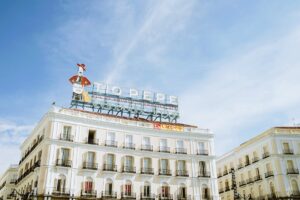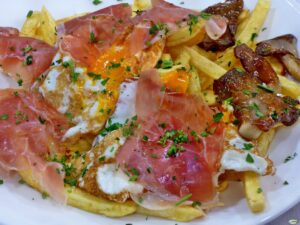Last Updated on December 12, 2025 by Emma Fajcz | Published: May 25, 2020
With some of the best wine for value out there, it’s no wonder the world is finally starting to catch on to the wonders of Spanish vino.
However, if you aren’t familiar with Spanish wine and don’t understand some of the concepts and terms that are unique to Spain, a Spanish wine label can seem difficult to understand. But it’s not as hard as it seems! In this guide, we’ll give you a complete breakdown of some of the most common Spanish wine terms and classifications.
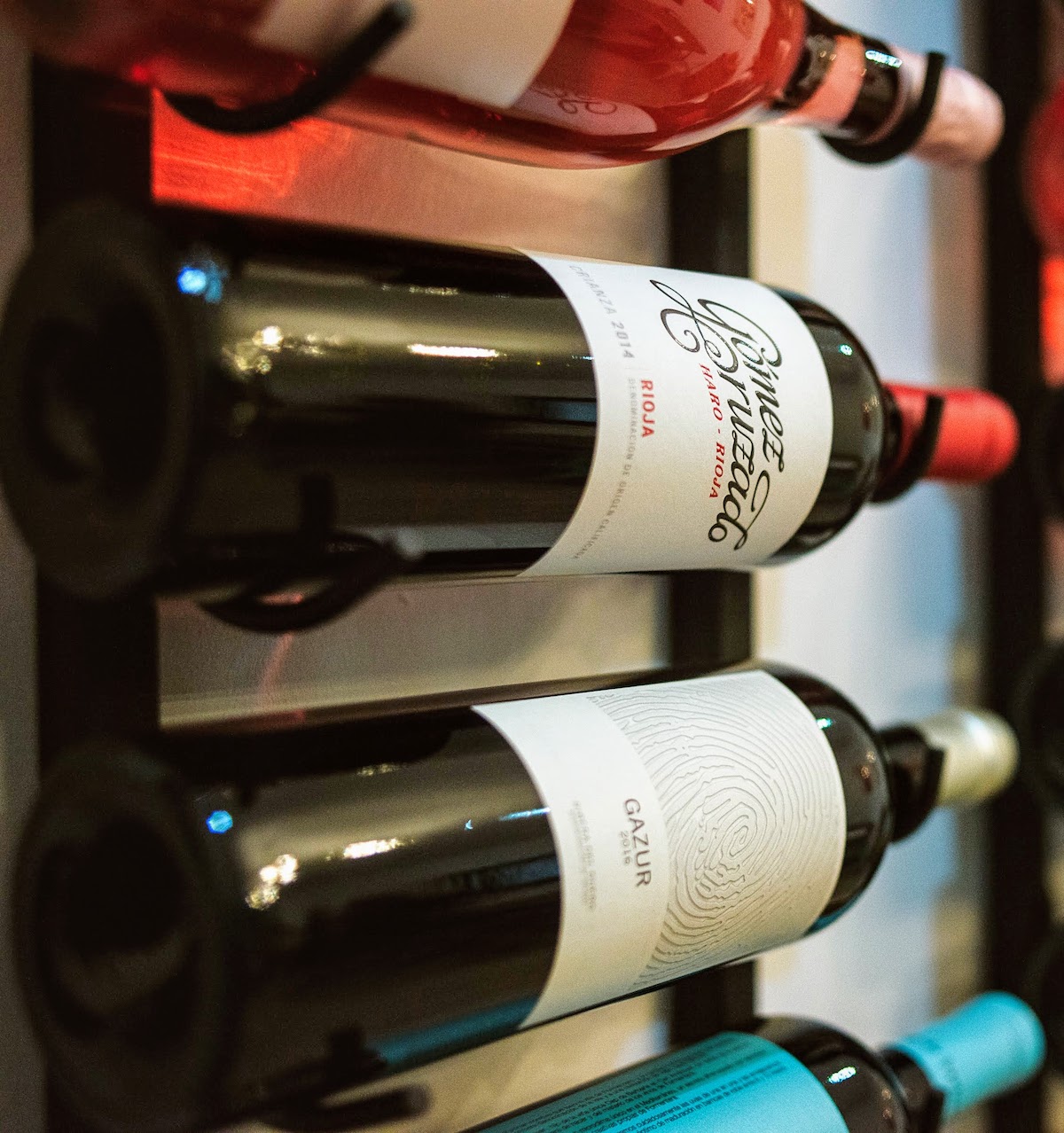
Wine is easily one of the best (and most delicious!) souvenirs you can bring back from Spain. But of course, it’s important to understand what you’re buying.
No matter whether you’re in Spain or browsing the aisles of your local wine shop at home, this guide will help better understand how to read a Spanish wine label so you can feel confident and pick the right bottle every time.
How to Read a Spanish Wine Label: The Basics
To get started, there are eight things that nearly every Spanish wine label will include.
- The name of the wine
- Region: The location of production; this includes quality classifications tied to that region such as D.O. (denominación de origen)
- Aging classification: The type of grape maturation
- Vintage: The year of the harvest
- The producer, or the bodega that made the wine
- A description of the wine (occasionally printed in English as well), including the grape varietal
- Percentage of alcohol by volume
- The official seal of the regional regulatory council, if applicable
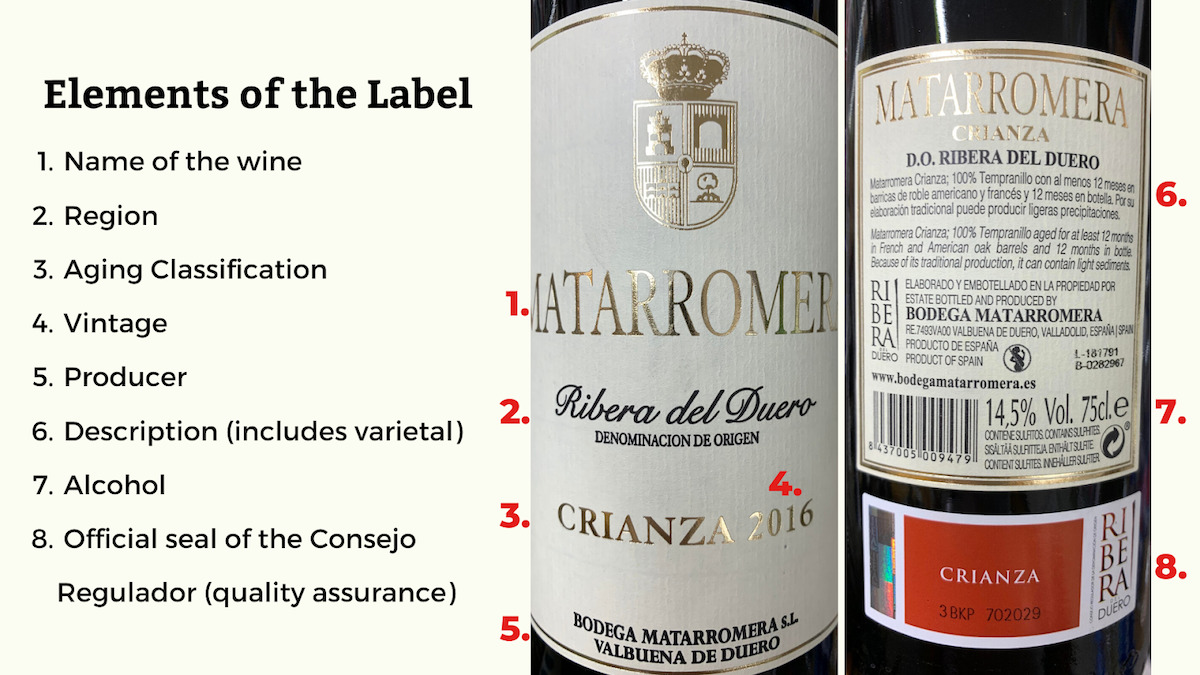
Now let’s break it down.
Region
The first thing to keep in mind is that Spanish wines are Old World wines (this includes all European wines and those from regions with very long histories of winemaking). That means they typically label based on region.
New World wines, on the other hand, label by grape varietal. That’s why, in the US, you would order a cabernet sauvignon or a chardonnay, rather than a “Napa Valley.”
When checking a Spanish bottle, the first thing to look for is the region. Oftentimes you will be able to find the varietal on the bottle, but that information almost always comes secondary to the region in which it was produced. Now why is that?
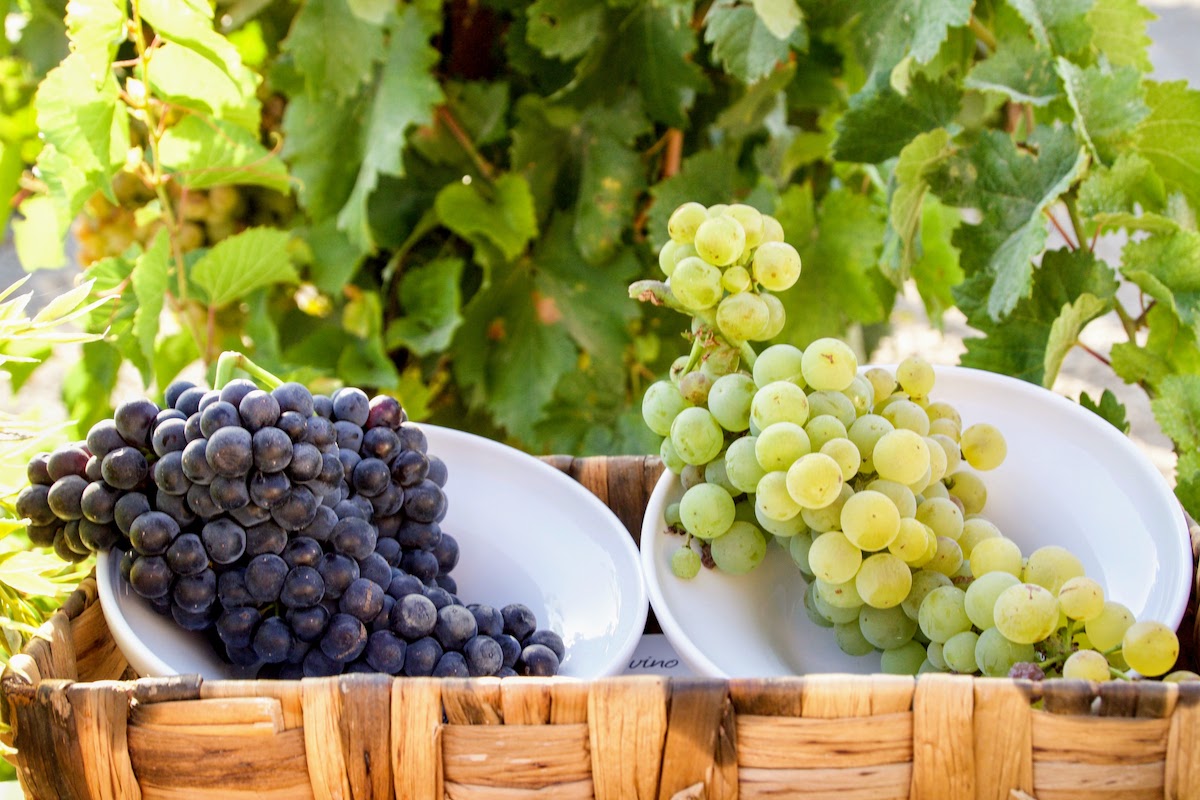
While many types of grapes grow in Spain, only a select few go into the majority of wines. Take tempranillo, for example.
Tempranillo comes from in many regions of Spain, and its character varies greatly depending on the production area. So buying a bottle of “tempranillo” tells you very little about the wine.
For example, a tempranillo from La Rioja is going to taste drastically different from a tempranillo from Toro. In fact, in Toro, a region to the west of La Rioja, tempranillo goes by another name, tinta del toro.
See? It can get a bit confusing when we start talking grapes. So that’s why we stick to the regions most of the time.
There are some select wines that label based on varietal, such as albariño and some monastrells. Also, sherry wines from the south of Spain are labeled by style, such as “fino” or “amontillado.” But generally speaking, region is key when labeling Spanish wine.
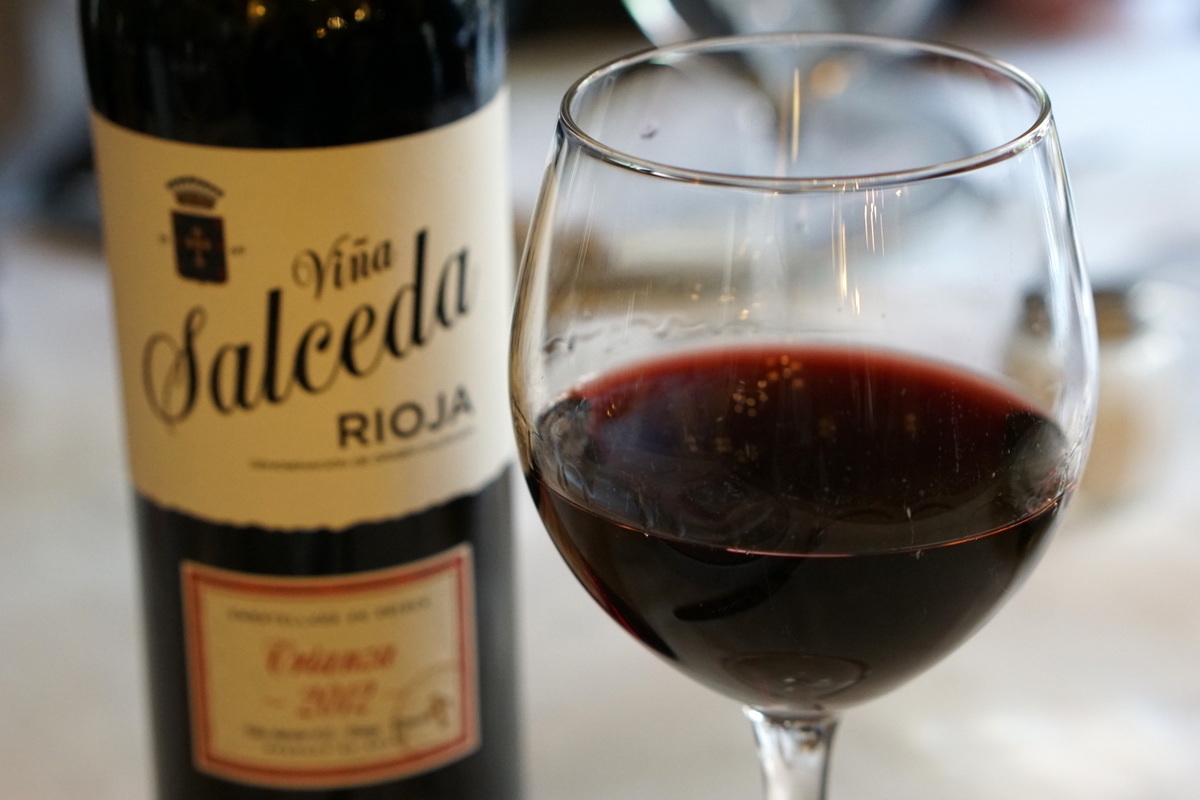
Grape Varietal
That said, most bottles will also include the grape varietals. Top varietals used in Spanish wine include tempranillo, garnacha and monastrell. Keep in mind that the grapes oftentimes won’t be front and center on the bottle, and sometimes they won’t be there at all.
Remember that there are certain wines that will be labeled primarily by the grape, such as those we listed above, but this isn’t the norm.
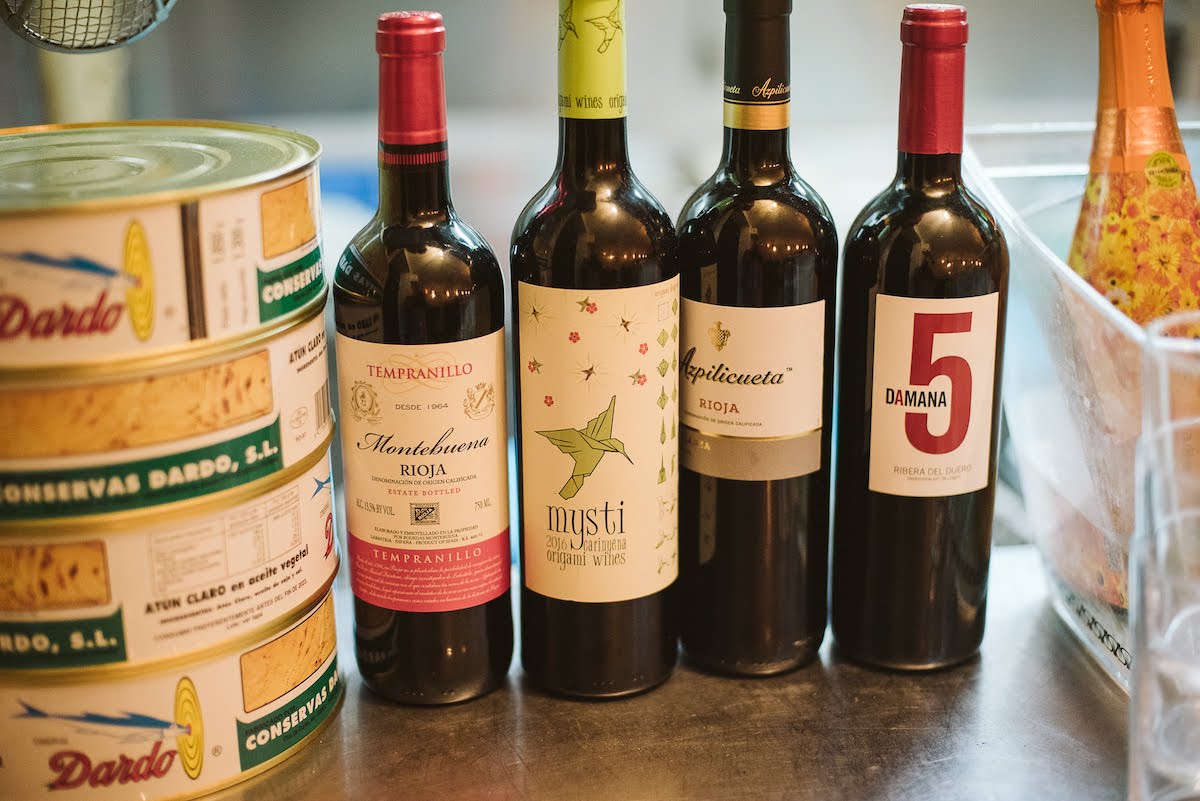
Quality Classification
Spanish wine is classified into several categories, one of which you’ll likely see on the label of your bottle. Here’s how to interpret the four most common quality indicators.
- Vino de mesa: Table wine, rarely found outside of Spain. These are basic wines that typically do not include a region, grape or vintage on the label. These can get a bad rap as the “lowest quality” wines, although there are some vinos de mesa from DO and DOCa regions which don’t meet all the regulations—therefore not earning the classification, but are still quite good.
- Vino de la Tierra: Literally, “wines of the land.” This refers to any wines from specific geographic areas outside of those that are DO classified and regulated. Many of these wines are of great quality and value, as they aren’t held back by the costs and regulations that come with DO and DOCa wines.
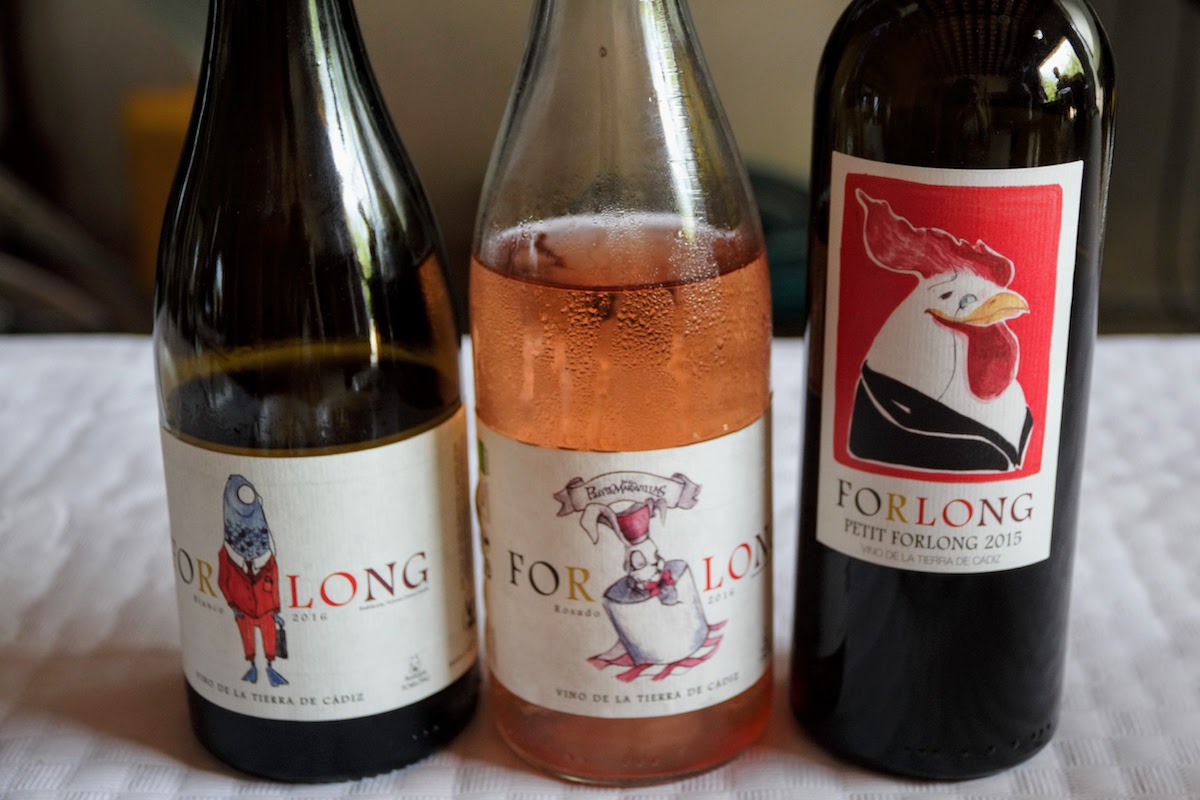
- DO or Denominación de Origen: These are governmentally regulated winemaking regions. Wines produced within a DO follow a series of quality standards and procedures. There are around 70 DO regions in Spain!
- DOCa, or Denominación de Origen Calificada: These are winemaking regions that have consistently produced top-quality wines; they have to meet higher regulation standards than DOs. There are only two regions in Spain with this certification: Rioja and Priorat.
Age
Understanding Spanish aging classifications is another way to ensure that you’re choosing the right wine, as aging and oak absolutely change the flavor and quality of the wine. However, age can be a little tricky, as many DOs will choose to enforce their own, even stricter classification systems.
To give you a general idea of aging requirements, we’ve outlined the standard classifications along with a couple of stricter requirements for popular regions such as La Rioja.
As a general rule of thumb, young (joven) wines tend to be quite fresh with fruit-forward flavors, while more aged wines will have flavors which can range from vanilla and oak to earthy mushroom and leather. But of course, that varies greatly from bottle to bottle. If you aren’t sure, take a look at the back label, where you can typically find descriptions of age, oak influence and flavor.
- Joven: Joven means “young,” so when you see this term on a bottle, it means that it is not meant to be aged and should be consumed within a year. These wines have spent little to no time in oak.
- Roble: “Oak” wine. If a bottle does not specify the time spent in the oak barrel, this means that it wasn’t for very long, typically three to six months.
- Crianza: The next step up from a joven wine. Red crianzas have aged for a minimum of two years, with at least six months spent in oak. White crianzas have aged for 18 months, with six months in oak. In regions such as La Rioja, requirements are more strict: red crianzas must be aged in barrel for 12 months.
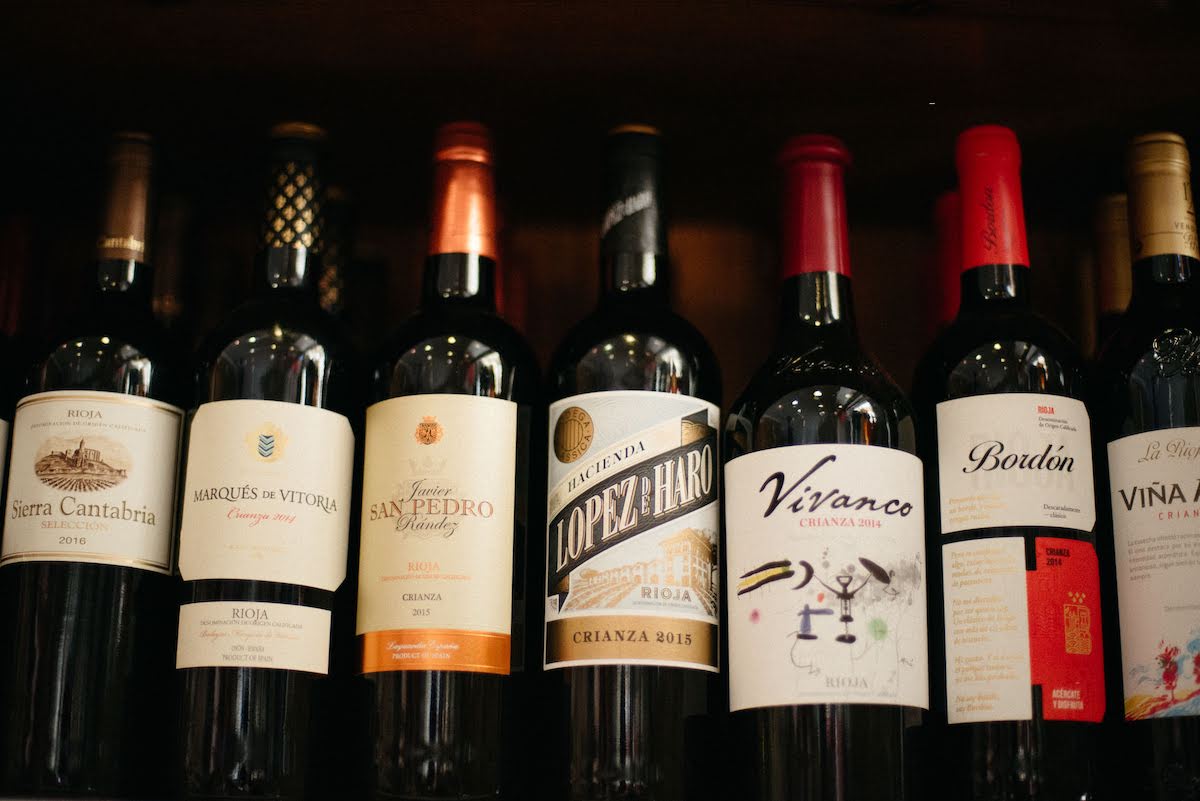
- Reserva: Reservas are wines from better, more promising vintages. Red reserva wines have aged for a minimum of three years, with at least 12 months in oak. White reservas have aged for two years, with a minimum of six months in oak.
- Gran reserva: These wines are only made from the best vintages. Red gran reservas have aged for at least five years, with a minimum of 18 months in oak. In La Rioja, they will spend 24 months in oak. White gran reservas must age four years with six months in oak. However, most producers will age well above the requirements and won’t release until they are peak quality.
If you’re confused, just remember crianza has some oak and aging, and reserva and gran reserva have more of both so they will be more complex—and therefore more expensive. But keep in mind that Spain has some of the best values in the entire world for wine, so it’s worth the splurge.
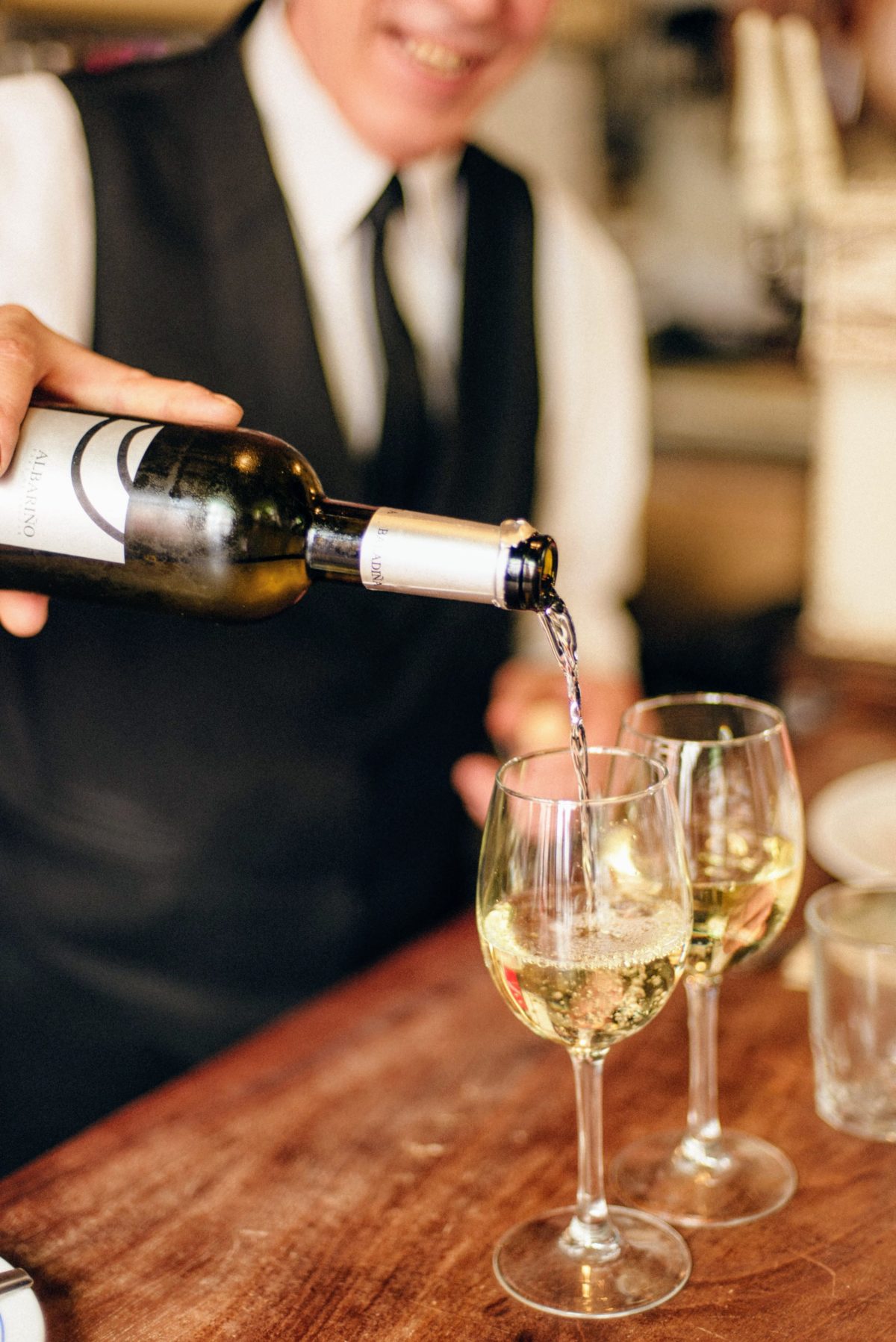
More Spanish Wine Terms
Now that you understand the basics of how to read a Spanish wine label, here are a few more wine-related vocab words that will help you understand exactly what’s going on inside the bottle.
- Altitud : Altitude
- Añejo : Wine aged at least 2 years
- Barrica: Barrel
- Boca: Mouth
- Bodega: Winery
- Calidad: Quality
- Clima: Climate
- Cosecha: Vintage, year of harvest
- Embotellado: Bottled
- Espumoso: Sparkling wine
- Fermentación: Fermentation
- Fruta madura: Ripe fruits
- Meses de crianza/en barrica/en botella: Months of aging/months in the barrel/months in the bottle
- Noble: Wine aged at least one year
- Roble: Oak
- Rosado: Rosé
- Sin cosecha: Without vintage
- Suelo: Soil
- Sulfitos: Sulphates
- Temperatura: Temperature
- Uva: Grape
- Variedad: Variety
- Viejo: “Old”—this refers to wines which have been aged for a minimum of three years, with distinctly oxidative styles
- Viñedo: Vineyard
- Vinificación: Winemaking
- Vino blanco: White wine
- Vino tinto: Red wine
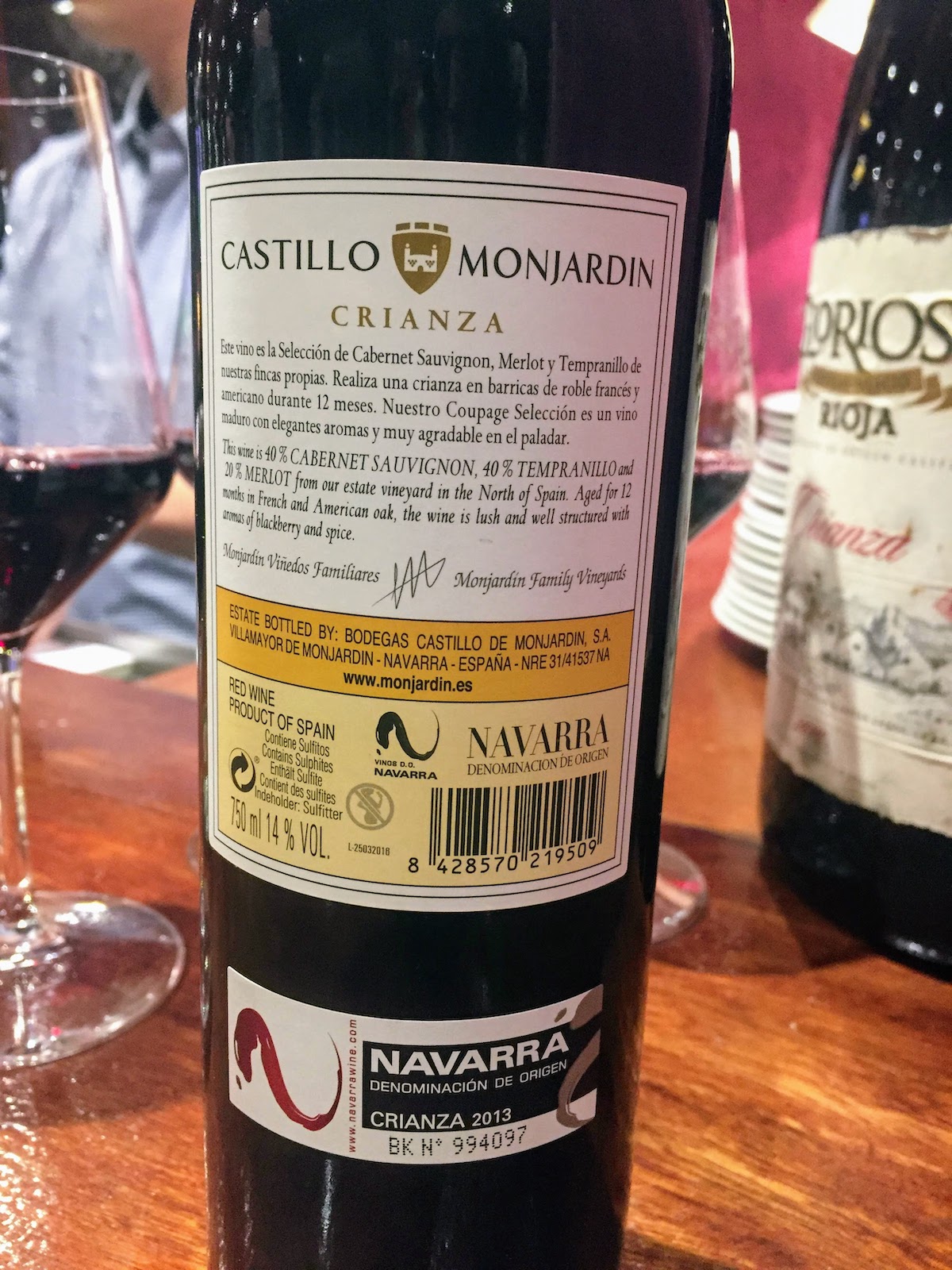
How to Read a Cava Label
When picking a bottle of Spanish bubbly like cava, there are a couple of extra considerations you should be aware of. But first, what exactly is cava?
Cava is a popular Spanish sparkling wine produced in eight of the autonomous regions in Spain, with the majority coming from the northeast, in Catalonia. It is produced using the méthode champenoise, the traditional method of making Champagne, in which the second fermentation occurs inside the bottle.
The only true difference between cava and its more famous French counterpart is that cava is made primarily with native Spanish grapes, and of course is produced in Spain. Due to the differences in geography, climate, and soil, though, the two wines couldn’t be more different.
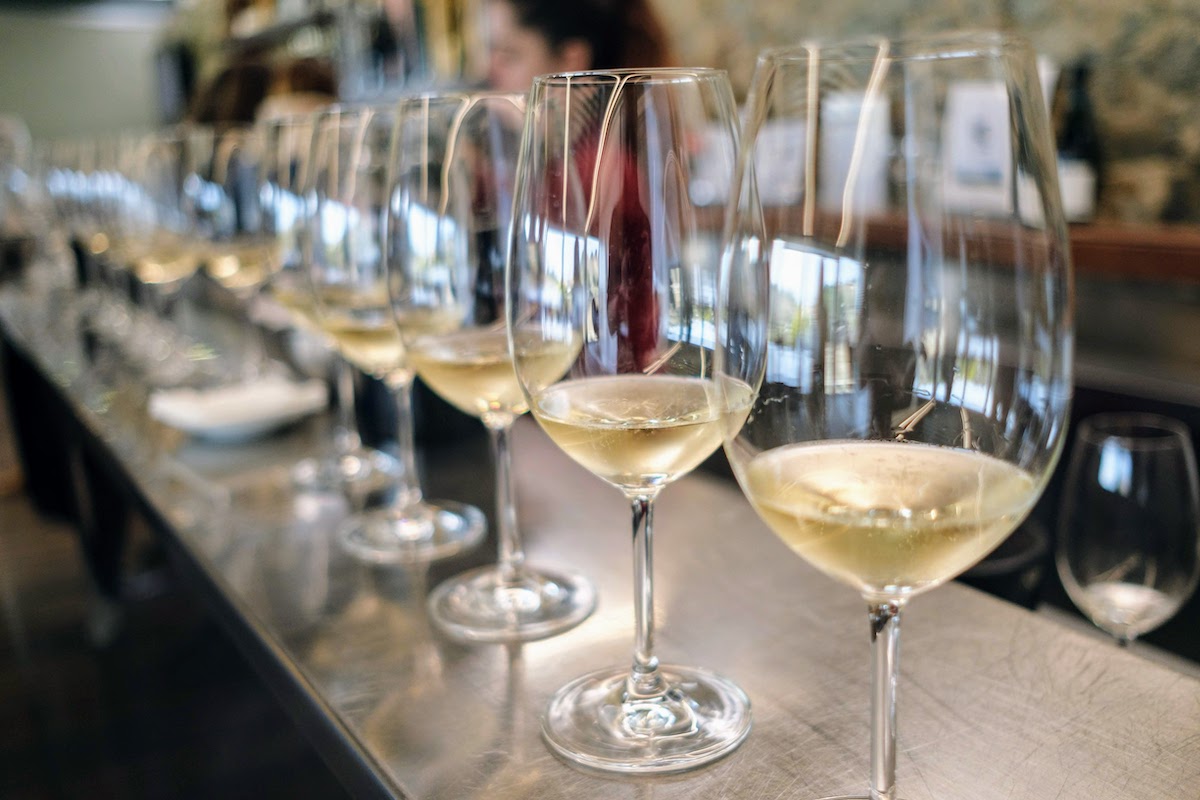
Unlike other Spanish wines, cava is categorized in two ways: by its sugar content and how long it’s been aged. Here are the terms to look out for.
Sugar Content of Cava
- Brut nature: The driest cava, with no sugar added during the winemaking process.
- Extra brut: Also a dry cava, this type can contain up to six grams of sugar per liter.
- Brut: This is the most popular type of cava in Spain and most common export. They are still quite dry, but can contain up to 12 grams of sugar per liter.
- Extra seco: Extra seco means extra dry, but these cavas actually lean more towards the sweeter side! They contain between 12 and 17 grams of sugar per liter.
- Seco: Again, seco means dry, but this cava is actually quite sweet, with between 17 and 32 grams of sugar per liter.
- Semi seco: With between 32 and 50 grams of sugar, these “semi dry” cavas are sweet!
- Dulce: The sweetest type of cava. And sweet they are, with 50 grams of sugar(or more!) per liter.
Aging Classifications of Cava
- Joven: Cava aged in its bottle between nine and 15 months. About 90 percent of cava is considered joven.
- Reserva: Cavas that have been aged for a minimum of 15 months. They tend to be darker in color and have more developed, nuttier flavors.
- Gran reserva: These are long-aged cavas which have spent at least 30 months aging. Gran reservas are only made with dry brut cavas.
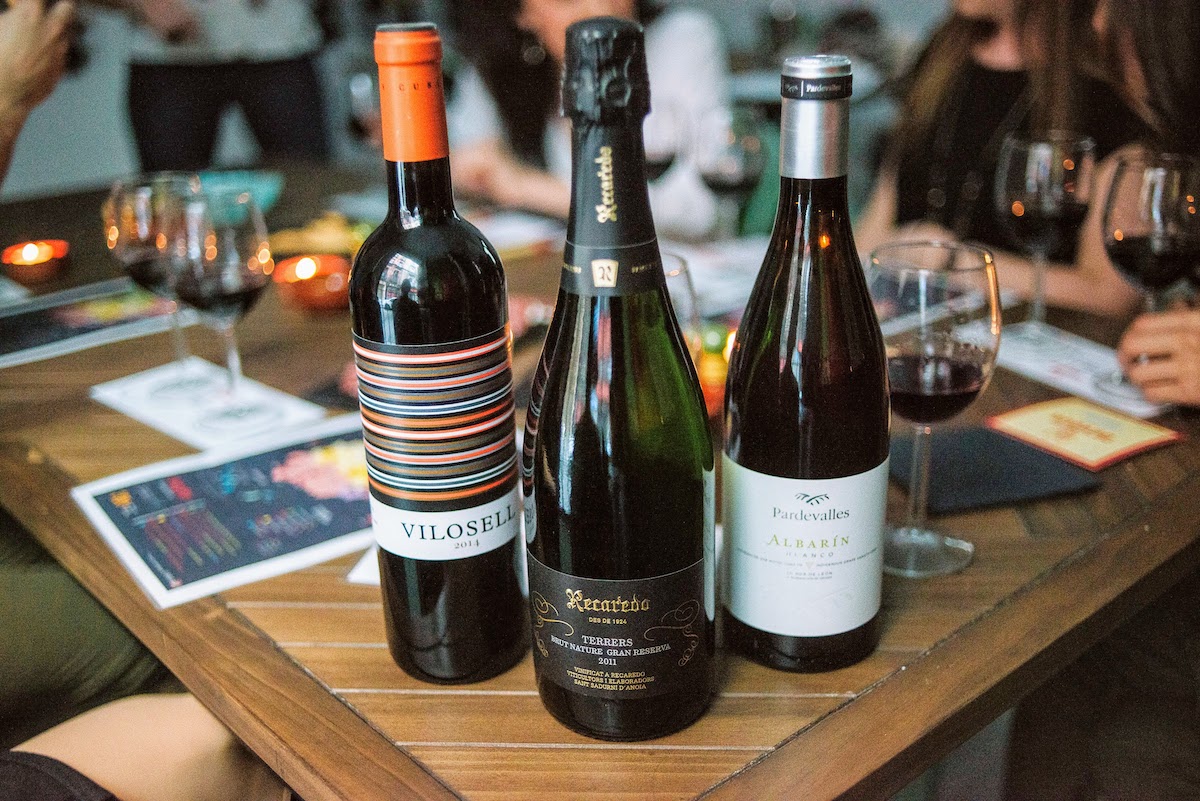
Spanish Wine Label FAQs
Crianza is an aging classification for Spanish wine. Wines labeled as crianza have aged for at least 18 months (for white wines) or two years (for red wines). Both red and white wines must spend at least six months of that time in oak. However, some regions such as La Rioja have stricter aging standards, and crianzas must age for even longer in oak barrels.
Tempranillo is a common Spanish red wine grape, and Rioja is a famous winemaking region in Spain. Many Riojas are made with the tempranillo grape, but not all tempranillos are Riojas.
DO stands for denominación de origen (denomination of origin). It is one of the most prestigious quality classification levels in the world of Spanish wine. Winemaking regions must meet strict, government-mandated standards in order to earn the coveted DO status.
Cosecha is the Spanish word for crop or harvest. In the wine world, it is often used before the year to indicate the vintage.
Like crianza, reserva is an aging classification. It indicates the second most-aged wines, with the most aged being gran reservas.
Usually made from higher quality vintages, reservas must spend a minimum amount of time aging to earn the label: three years (with at least 12 months in oak) for red wines, and two years (with at least six months in oak) for whites.
Rioja is a winemaking region, and crianza is an aging classification in the world of Spanish wine. Many Rioja wines are also crianzas, depending on how long they were aged.
Explore Madrid’s Cuisine Like a Local
Join one of our top-rated Madrid food tours! With the help of our expert local guides, you’ll get to see, hear, and taste your way through Madrid and learn about its fascinating history and culture.
